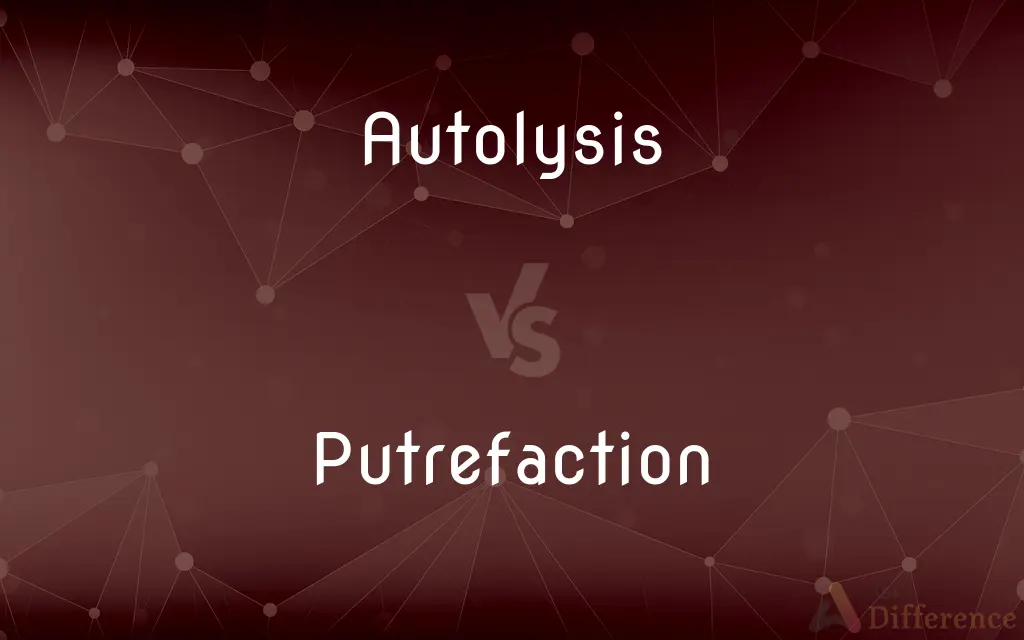Autolysis vs. Putrefaction — What's the Difference?
By Urooj Arif & Fiza Rafique — Updated on March 17, 2024
Autolysis is the self-digestion of cells by their own enzymes, while putrefaction involves decomposition by bacteria or fungi.

Difference Between Autolysis and Putrefaction
Table of Contents
ADVERTISEMENT
Key Differences
Autolysis occurs when a cell's enzymes break it down from the inside after death, leading to cellular self-digestion. This process begins soon after death and is considered a sterile process as it does not involve external organisms. Whereas, putrefaction refers to the decomposition of the body's proteins by bacteria and fungi, leading to the production of gases, odors, and body fluids. This process is not sterile and is associated with the visible signs of decay.
In the context of food preservation, autolysis is a process that can be desirable in certain food products, such as in the aging of cheese and wine, where it enhances flavor and texture. On the other hand, putrefaction is universally undesirable in food preservation, as it indicates spoilage and the presence of potentially harmful microorganisms.
From a forensic perspective, autolysis is an early postmortem change that helps in estimating the time of death during the initial stages, as it begins soon after death and progresses at a predictable rate. Conversely, putrefaction is a later stage of decomposition that provides forensic clues to the time of death but over a longer and somewhat less predictable timeframe.
Autolysis is primarily an enzymatic process that involves intracellular enzymes, and its rate can be influenced by factors such as temperature and the pH of the tissue environment. Putrefaction, however, is greatly influenced by external factors, including temperature, humidity, and the presence of bacteria and fungi in the environment.
While autolysis is a more controlled and self-contained process within cells or tissues, putrefaction is a complex, multi-factorial process that involves the entire body and results in more profound morphological and chemical changes due to the action of external decomposers.
ADVERTISEMENT
Comparison Chart
Definition
Self-digestion of cells by their own enzymes
Decomposition of organic matter by bacteria or fungi
Process
Sterile and enzymatic
Non-sterile and microbial
Products
Cellular breakdown products
Gases, odors, and body fluids
Impact on Food
Can enhance flavors in certain foods
Indicates spoilage
Forensic Relevance
Helps estimate early postmortem interval
Used to estimate later stages of decomposition
Compare with Definitions
Autolysis
Used in food processing.
Autolysis contributes to the flavor of aged cheese and wine.
Putrefaction
External process.
Putrefaction involves external decomposers acting on the body.
Autolysis
Self-digestion by enzymes.
Enzymes within a cell break down its components after death.
Putrefaction
Influenced by environmental factors.
Temperature and humidity greatly affect the rate of putrefaction.
Autolysis
Sterile process.
Autolysis involves only the cell's own enzymes, without external bacteria.
Putrefaction
Non-sterile process.
Putrefaction is characterized by the involvement of various bacteria and fungi.
Autolysis
Occurs internally.
Autolysis starts inside cells, affecting tissues from within.
Putrefaction
Indicates food spoilage.
Putrefaction in food is a sign of spoilage and potential health risks.
Autolysis
Influenced by internal factors.
The rate of autolysis is affected by the cell's environment and temperature.
Putrefaction
Putrefaction is the fifth stage of death, following pallor mortis, algor mortis, rigor mortis, and livor mortis. This process references the breaking down of a body of an animal such as a human post-mortem (meaning after death).
Autolysis
The breaking down of cells or tissues by their own enzymes. Also called self-digestion.
Putrefaction
An amount of putrefied matter or an odor produced by such matter.
Autolysis
The destruction of an organism's cells by enzymes produced by the organism itself.
Putrefaction
The process of decay or rotting in a body or other organic matter
The breeze shifted and we caught the stench of putrefaction
Autolysis
(pathology) The autodigestion of the tissues of an organism.
Putrefaction
Decomposition of organic matter, especially protein, by microorganisms, resulting in production of foul-smelling matter.
Autolysis
(baking) A two-stage mixing process where water and flour are combined first before adding leavening and salt.
Putrefaction
The act of causing to rot; the anaerobic splitting of proteins by bacteria and fungi with the formation of malodorous, incompletely oxidized products.
Autolysis
Lysis of cells or tissues due to enzymatic activity from within the cell, as contrasted with externally induced lysis.
Putrefaction
Rotten material.
Autolysis
Lysis (self-digestion) of tissues when they are detached from the organism
Putrefaction
The state of being rotten.
Putrefaction
The act or the process of putrefying; the offensive decay of albuminous or other matter.
Putrefaction
The condition of being putrefied; also, that which putrefied.
Putrefaction
Decay usually accompanied by an offensive odor
Putrefaction
(biology) decaying caused by bacterial or fungal action
Common Curiosities
How do autolysis and putrefaction differ in their processes?
Autolysis is an internal, enzymatic process, while putrefaction involves external bacteria and fungi.
What causes putrefaction?
Putrefaction is caused by the decomposition of organic matter by bacteria and fungi.
Is putrefaction a sterile process?
No, putrefaction is a non-sterile process involving external microorganisms.
What is autolysis?
Autolysis is the self-digestion of cells by their own enzymes, typically occurring after cell death.
Are there any methods to slow down putrefaction?
Refrigeration and embalming are common methods to slow down putrefaction.
Can autolysis occur in living organisms?
Autolysis primarily occurs after death, though similar processes can happen in dying tissues.
What are the signs of autolysis?
Signs of autolysis include cellular breakdown and the loss of cell integrity.
How does temperature affect autolysis and putrefaction?
Temperature can accelerate both autolysis and putrefaction, but putrefaction is more sensitive to environmental conditions.
Can autolysis be beneficial in food production?
Yes, autolysis can enhance flavors and textures in products like cheese and wine.
How do pH levels affect autolysis?
pH levels can influence the rate of autolysis, as enzymes have optimal pH ranges.
What are the signs of putrefaction?
Putrefaction is marked by the production of gases, odors, and body fluids, and visible decay.
What role does autolysis play in forensic science?
Autolysis helps in estimating the early postmortem interval.
Can putrefaction occur in all types of environments?
While it can occur in many environments, factors like temperature and humidity greatly affect its rate.
Why is putrefaction undesirable in food preservation?
Putrefaction indicates spoilage and potential health hazards due to harmful microorganisms.
What role does putrefaction play in forensic investigations?
Putrefaction provides clues to later stages of decomposition and the time of death.
Share Your Discovery

Previous Comparison
Batting vs. Stuffing
Next Comparison
Antinomy vs. ParadoxAuthor Spotlight
Written by
Urooj ArifUrooj is a skilled content writer at Ask Difference, known for her exceptional ability to simplify complex topics into engaging and informative content. With a passion for research and a flair for clear, concise writing, she consistently delivers articles that resonate with our diverse audience.
Co-written by
Fiza RafiqueFiza Rafique is a skilled content writer at AskDifference.com, where she meticulously refines and enhances written pieces. Drawing from her vast editorial expertise, Fiza ensures clarity, accuracy, and precision in every article. Passionate about language, she continually seeks to elevate the quality of content for readers worldwide.















































